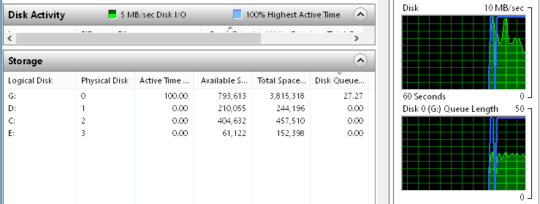1
1
Let's say there are 25 processes each which want to read and index a large (say, 1GB) file. The hard drive may be capable of ~100MB/sec throughput, but the head movement and rotational latency involved in moving between such processes is significant so may reduce throughput to 5MB/sec, or just 5% of the conventional drive's throughput capability.
Were the hard drive to read a large amount of data (say, 32MB) or read whatever it can for a long time (say, 200ms) before moving onto the next process, file IO could approach the full throughput of the drive at the expense of latency.
Does Windows have such a facility for accomplishing this goal in cases where latency takes a back seat to throughput?

check the tool DiskSpd: http://blogs.technet.com/b/josebda/archive/2014/10/13/diskspd-powershell-and-storage-performance-measuring-iops-throughput-and-latency-for-both-local-disks-and-smb-file-shares.aspx
– magicandre1981 – 2014-11-01T07:11:29.720